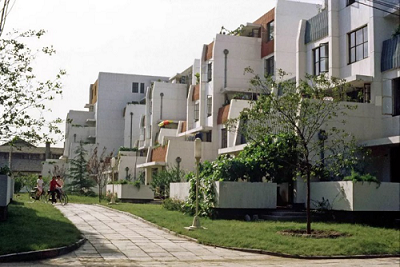清华大学建筑设计研究院建院60周年回顾展
THAD 60th Anniversary Exhibition
6X10一个大学设计院的现代建筑史
6 X10 A Modern History of Architecture by THAD

主办Host:清华大学建筑设计研究院 / 清华大学建筑学院
Architecture Design and Research Institute of Tsinghua University
School of Architecture, Tsinghua University
承办Co-Host:清华大学《住区》杂志 Design Community Magazine
总策划 Director:庄惟敏 ZHUANG Weimin
执行策划 Executive Director:刘玉龙、王韬、杨丝路、黄献明、屈小羽、李文虹、王彦
LIU Yulong, WANG Tao, YANG Silu, HUANG Xianming, QU Xiaoyu, LI Wenhong, WANG Yan
展陈设计 Exhibition Design:Martijn de Geus、张涵 ZHANG Han
展览统筹Coordination:巩金蕊、李鑫瀚、陈芳、王若溪
GONG Jinrui, LI Xinhan, CHEN Fang, WANG Ruoxi
在现代建筑史中,大学与设计院相互制约并相互激发,在不同时期交替担任着传承者或革新者的角色,推动着现代建筑的发展。当其中一方趋于保守,另一方就会酝酿变革;当一方狂飙突进,另一方就会视传承为己任。1958年,拥有建筑学专业的一批中国大学成立了自己的设计院,大学与设计院第一次被融为一体,成为中国乃至世界建筑界一个特殊的现象,清华大学建筑设计研究院就是其中之一。自此,大学设计院的发展就和中国现代建筑紧密的结合在一起。60年后的今天,我们在清华大学建筑设计研究院成立60周年之际,策划了这个名为“一个大学设计院的建筑史”的展览。因为,当我们回首清华大学建筑设计研究院这六个十年,会发现其研究与实践与中国社会经济的脉动、城乡建设的发展、设计思潮的起伏密切相连。既反映着中国这60年的建筑实践,也呈现了中国建筑学术的发展。因此,这既是一个大学设计院的发展历程,也是中国现代建筑史的一个缩影。
In the history of modern architecture, universities and design offices have always had a mutual-constraining and mutual-inspiring relationship, propelling the development of architecture. When one side becomes conservative, the other brews revolution; one focuses on development, the other then takes retaining tradition its responsibility. In 1958, universities in China formed their own design offices. For the first time in history, the university and the design office were integrated into one – University-based Design Office (UDO). From then on, the development of UDO has been closely knitted into the history of modern architecture of China. Six decades have passed, at the day of the 60th anniversary of Architecture Design and Research Institute of China of Tsinghua University (THAD), we present this exhibition – “A History of Modern Architecture by THAD”. When we review the last 60 years, we can see that the development of THAD and its works are directly echoing with the socio-economic background, urban development and architecture trends. It is a 60-year history of architecture practice, as well as a history of academic exploration under given circumstances. Therefore, the exhibition presents the path travelled by THAD in the past 60 years, and it can also serve well as a vivid section of the history of modern architecture of China.
1958-1967:构建认同
Constructing Identity1949年之前,中国建筑的一个重要命题就是寻找一种结合西方现代理念和中国传统的建筑语言。1949年之后,在这个命题之上,又增加了一个更重要和紧迫的使命:随着中华人民共和国的建立,如何让一种新的社会制度下的建筑形成一种新的社会与城市环境,既和过去有所不同(传统时期以及民国时期),同时又能宣示一个新时代的到来?两个命题的核心是一致的,那就是建筑设计要在新的社会关系、生产方式和思想观念下,塑造一种新的国家与民族认同。清华大学设计院正式成立在1958年,由于其与清华大学建筑系发展密不可分的关系,其自建立初期直到1966年的设计实践中,始终贯穿了塑造国家与民族认同的使命。
Before 1949, an important proposition of China architecture was to seek for a type of architecture language capable of combining western modern idea and Chinese tradition. After 1949, another more important and urgent mission was added to this proposition: with the foundation of the People’s Republic of China, how to form a new social and urban environment by buildings under the new social institution so as to be different from the past (traditional period and the Republic of China) while declaring the coming of a new era? The two propositions shared the same core that architecture design shall characterize a new recognition of country and nation under new social relationship, production mode and ideology. THAD was formally established in 1958 and due to its inseparable relationship with the Department of Architecture of Tsinghua University, the mission of characterizing the recognition of country and nation ran through all its designs since the establishment until 1966.
社会经济背景Socio-economic Development
城市发展 Urban Development
国内外建筑思潮Architecture Trends
THAD设计实践案例 Works by THAD

清华大学1-4号宿舍楼

清华大学第二教学楼
1968-1977: 工业化与意识形态
Industrialization and Ideology建筑发展不可避免的受到社会工业和技术条件与意识形态的影响。自第一个五年计划计划以来,中国迈上了工业化的道路,在建筑设计中也引入了现代建筑设计方法、技术、规范和标准,这也体现在清华大学设计院自建国以来一系列的设计实践中。而到了1966年文化大革命开始,工业化的步伐虽然仍在继续,但是意识形态的因素开始全面压倒了工业与技术的发展进程。建筑设计中在这个时期的两个特征是,一方面,工业化的发展向国防与三线建设倾斜,另一方面是极左意识形态下出现的一些特殊建筑类型,以及建筑与城市发展的停滞和管理的无政府化。
Architecture was inevitably influenced by social, industrial and technical conditions and ideology when moving on. China had stepped on the road to industrialization since the first “five-year” plan, and methods, technologies, specifications and standards of modern architecture were also introduced into architecture design, which was reflected in a series of designs of THAD since the foundation of new China. However, when it came to 1966, as the Great Cultural Revolution started, the factor of ideology also started to overwhelm from all facets the development and progress of industry and technology, though the industrialization kept moving on. Two features of architecture design during this period were the emphasis of industrialization on national defense and three-line construction and the influence of ultra-left ideology under which some special types of architecture appeared, architecture and urban developments stopped and management was caught into anarchy.
社会经济背景Socio-economic Development
城市发展 Urban Development
国内外建筑思潮Architecture Trends
THAD设计实践案例 Works by THAD

清华大学主教学楼
1978-1987: 改革开放
Reforms and Opening-up1978年开始中国进入了改革开放的时期。十年动乱结束,建筑设计发展回归正常化。对于计划经济体制的改革带来了建设投资机制的变化,为建筑设计注入了新的活力;对外开放则带来了国外建筑发展的信息和交流,促进了建筑学术和实践的发展。清华大学设计院也在这个时期也开始回归建筑设计研究的本体,吸收国外先进的理论与方法,开启了新的研究与实践。随着基本建设投资体制的变化、公有住房制度的改革以及土地开放市场的放开,也给建筑设计行业本身带来了新的变化,除了计划经济时期自上而下的建筑设计任务,这个时期有了更多社会自身发展带来的自下而上的建筑需求,这也深刻地影响了这个时期清华大学设计院的设计实践。建筑设计不再仅仅是服务于国家需要,变得更加贴近社会、更加贴近生活。
China entered the period of reform and opening-up since 1978, and architecture design finally returned to normal after the ten chaotic years ended. The reform of planned economic system brought over changes to construction system and investment system and invigorated the design of architecture; the opening-up brought in information and exchanges on architecture development of foreign countries, facilitating academics and practices of architecture. THAD also started to return to the architecture design in itself during this period, absorbing advanced theories and methods and enabling new researches and practices. Changes of infrastructure investment system, reform of public-owned housing system and decontrol of land market brought new changes to the industry of architecture design. Besides the from-top-to-bottom architecture design task as left by planned economic system, during current period, there were more and more from-bottom-to-top architecture demands as generated by social developments, which profoundly influenced designs of THAD. Architecture design was no longer exclusive for needs of the country, but more close to society and life.
社会经济背景Socio-economic Development
城市发展 Urban Development
国内外建筑思潮Architecture Trends
THAD设计实践案例 Works by THAD

台阶式花园住宅

云谷山庄
1988-1997: 市场与社会
Market and Society土地开发机制的出现,市场化住房供应的建立,对建筑设计提出了市场与社会双方面的要求。市场化的需求代表了新时期对于私人需求的认可,而共同价值仍然是不可缺少的社会粘合剂。清华大学设计院在这个时期的实践,从市场和社会两个角度呈现了这个市场化蓬勃发展时期的双重使命:私人市场在逐步建立、社会共同进步仍然不可或缺。另一方面,在经济快速发展,西方先进思想和技术大量快速涌入的同时,重估自身传统文化价值的命题再度浮现。作为中国学术共同体中重要的一员,以探寻和总结建筑设计学术方法与理论为己任,清华大学设计院在这个时期的设计实践中,在服务于市场需求和社会价值的同时,也主动承担了挖掘、保护和再现中国传统建筑与城市文化价值的责任。
The appearance of land development mechanism and the establishment of system that provided housings in a marketization manner proposed to architecture design their requirements from views of both market and society. The marketization demand represented the acknowledgement to private demand in a new era, while common value was still a necessary social adhesive. Designs of THAD during this period reflected, from views of both market and society, these two missions in the background of vigorous development of marketization: private market was gradually establishing and common social progress was still necessary. On the other hand, while the economy rapidly developed and masses of advanced western ideas and technologies flooded in as fast as possible, the proposition of revaluating our own traditional culture emerged again. As an important member of China Academic Community, by taking the exploration and the summarization of academic methods and theories of architecture design as its own mission, designs of THAD during this period voluntarily assumed responsibilities of exploring, protecting and reappearing culture values of traditional Chinese architecture and cities while serving for market demands and social values.
社会经济背景Socio-economic Development
城市发展 Urban Development
国内外建筑思潮Architecture Trends
THAD设计实践案例 Works by THAD

北京体育学院体育馆

清华大学图书馆三期
1998-2007:大事件与大视野
Events and Horizon随着经济社会的发展、中国的对外开放、媒体与信息交流的激增,在建筑设计研究与实践的基础上,吴良镛先生提出了人居环境科学理论,以宏观视野将建筑、城市、景观相结合,将社会、文化、环境、技术等问题相融汇,成为指导建筑设计学术与实践发展的框架。这个时期,清华大学设计院的设计实践也越来越多的介入国家社会的大事件,并以广阔的学术视野,将其纳入到人居环境问题的研究中去,将学术研究与具体的设计实践紧密结合在一起,从而呼应更为广阔的社会发展需求,服务于学科发展的目标。例如,2008年在北京举行的奥运会,清华大学设计院参与了其中数个主要场馆的设计;同时,清华大学设计院还开展了工业化建造体系的开发、使用后评估方法的推广等具有更为宽广社会示范效应的研究和实践。
With developments of economy and society, opening-up of China and surge of media and information exchange, based on researches and practices of architecture design, Mr. WU Liangyong proposed a scientific theory on habitat environment that integrated architecture, city and landscape and incorporated culture, environment and technology etc. from a macro perspective. This theory has become the frame guiding the developments of academics and practices of architecture design. Designs of THAD during this period were involved in more and more national and social affairs and integrated them into researches on habitat environment from a broader academic perspective so as to closely combine academic researches and specific designs, calling for more extensive demands of social developments and better serving the target of developing relevant disciplines. For example, THAD has participated in designing many important venues of 2008 Beijing Olympics; meanwhile, THAD also developed the industrialization construction system and promoted the post occupation evaluation method, including many other researches and practices with more extensive social demonstration effects.
国内外建筑思潮综述 Architecture development
THAD各建筑类型的发展描述与实践案例 THAD practice by building categories
文化 Culture
教育 Education
体育 Sports
科研 Research
居住 Housing
文保 Heritage
人居环境其他诸领域 Other aspects of human settlements

北京大学图书馆(新馆及旧馆改造)

北京科技大学体育馆(2008年奥运会柔道、跆拳道比赛馆)
2008-今天:探寻现代性
Explore Modernity在最近这个十年中,清华大学的设计实践越来越紧密的和社会发展结合在一起,其学术与实践并重的路线在不断发扬光大。在参与社会大事件上,清华设计院参与了亚洲投资银行总部设计、北京冬奥会场馆规划设计、雄安新区规划设计等重要项目。在城镇化发展领域,清华设计院介入了新农村建设、城乡协调发展的工作。在响应市场需求上,清华设计院承接了越来越多不同类型和特点的设计任务,服务于不同的人群与需求。在建筑设计发展的前瞻性上,清华设计院正在努力推动建筑策划与使用后评估工作的普及,以使社会资本投入更为有效、使用者需求更有保障。在文化遗产保护上,清华设计院完成了大量城




